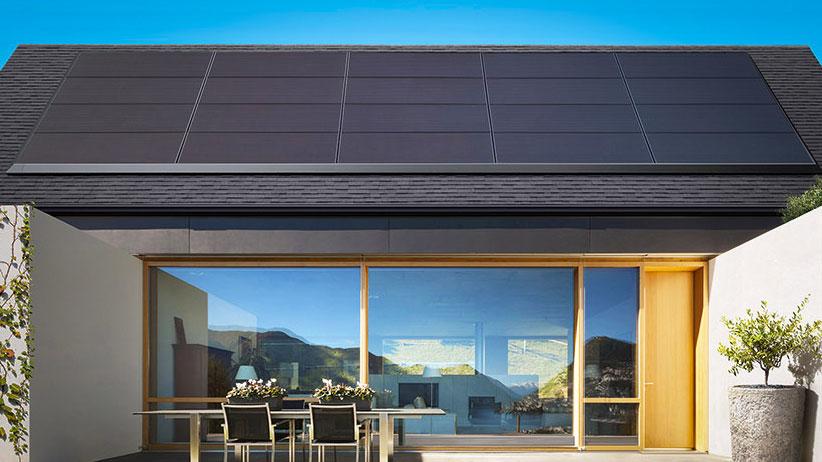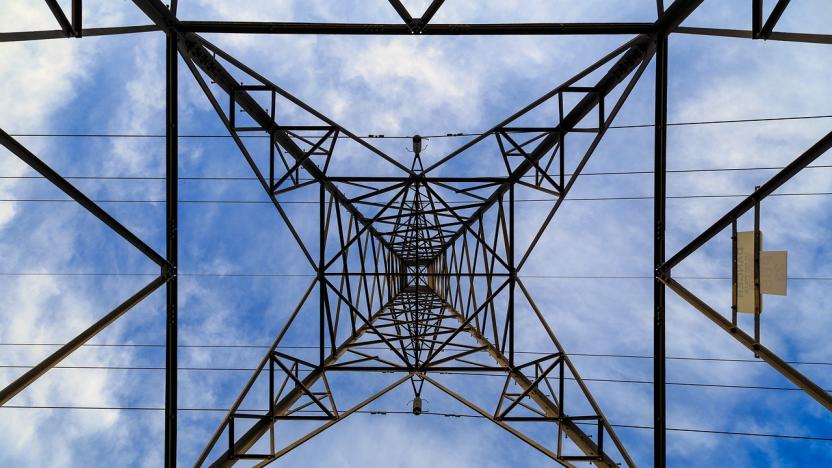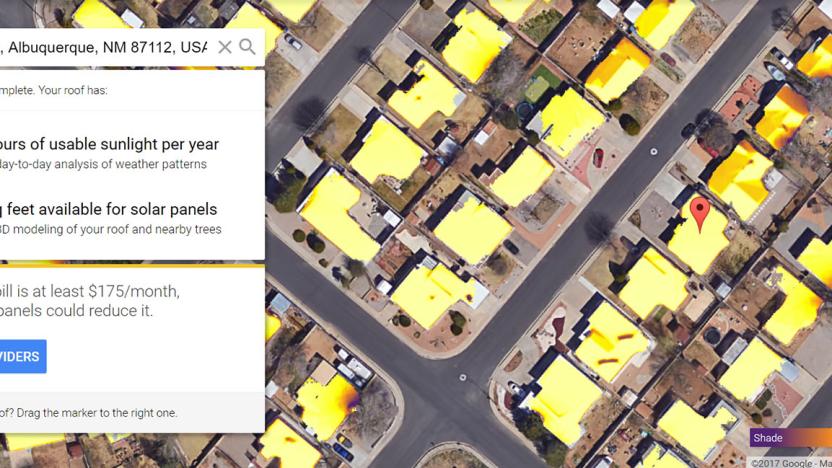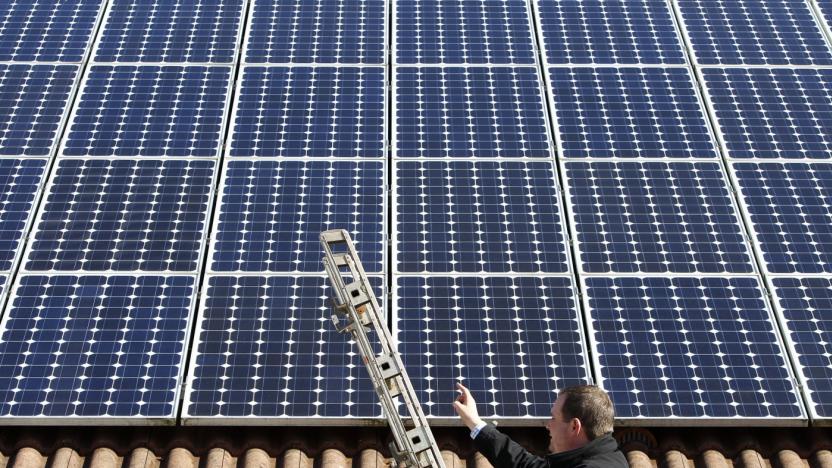solarpanels
Latest

NASA's InSight lander delivers its first clear photo from Mars
Earlier today the InSight lander successfully touched down on Mars, and it's already crushing the 'gram. Signals indicating that its solar panels had opened and were generating power came back to Earth at about 8:30 PM ET, along with a few photographs relayed via another visitor to Mars: the Odyssey orbiter. While it's expected to take two to three months to fully deploy the lander's instruments, this image came from its Instrument Deployment Camera which is mounted on a robotic arm.

Tesla will sell solar panels and Powerwalls at Home Depot
Just how much is the average consumer interested in solar power? Tesla is about to find out, as it is bringing photovoltaic panels and Powerwall batteries to US retail giant Home Depot, Bloomberg reports. Elon Musk's company will install Tesla-branded selling spaces at 800 locations, with its own employees on hand to explain the benefits. Later on, sources say it may also bring the much-anticipated solar roof, which generates electricity but looks and costs like a regular (high-end) roof.

Trump's new solar tariffs could kill 23,000 US jobs
As expected, US President Donald Trump has imposed a 30 percent tariff on solar cells imported into the US, mainly from Asia, a move that could bring the booming residential solar industry to a screeching halt. The levies are less than those requested by the US solar cell manufacturers that brought the dispute to US regulators to begin with. However, they were vehemently opposed by Tesla and other large players in the US solar energy industry, who say they will wipe out high-paying jobs in a promising new sector of the economy.

Green tech will be everywhere in 2018
In 2017, clean power gathered unprecedented momentum. Multiple automakers launched entire families of EVs, including the most exciting one yet, Tesla's Model 3. The company also started pre-orders for the Solar Roof, a type of home photovoltaic panel that will make solar panel installations less ugly. With climate change problems mounting, national and local governments are pushing for more renewable energy and an end to fossil-fueled cars -- despite hostile moves in those areas by US President Donald Trump. Elected officials and the public want fewer gas-powered vehicles and coal plants, and more EVs, solar panels and wind turbines. That will ultimately benefit your health, wallet and environment, and you'll be less reliant on large energy and oil corporations, to boot.

What is the future of Puerto Rico’s energy grid?
Delivering power to the inhabitants of a small island is a very different challenge to the sort found in other places. Resource poverty can mean that vital supplies need to be brought in, either by air or sea, purchased at a premium. The environment often offers its own bundle of problems, including the fact that the prevalence of salt water often corrodes mechanical equipment. Fast-growing vegetation and rocky terrain can compound the issue, making power networks hard to build and maintain.

Your solar panels could power the neighborhood during a blackout
A new set of algorithms could make it possible for renewable energy-generating homes to not only access their power reserves during outages, but share their resources with their neighbours -- a move which could play a significant role in disaster relief efforts. Self-sufficiency is an attractive factor when it comes to domestic renewable energy, but even though it's the sun generating electricity, owners of solar panels are still beholden to the grid. During an outage, their equipment powers down for safety reasons, and it's impossible to draw on the renewably-generated electricity that's waiting to be used. We've seen companies produce kit to overcome this before -- Tesla's Powerwall home battery system can untether a home from the grid for a few hours, for example -- but researchers from the University of California San Diego want to scale up the technology to have a wider and more meaningful impact.

Stanford toughens up cheap solar cells by mimicking insect eyes
While silicon solar panels are already providing electricity for a lot of homes and buildings, it doesn't mean researchers have stopped looking for better and cheaper alternatives. Case in point, a team of Stanford scientists working to make a cheaper photovoltaic mineral called perovskite a viable option for people who want to shift to solar. Perovskites are as efficient as silicon solar cells when it comes to converting sunlight into energy, but they're fragile and can deteriorate easily when exposed to the elements. The team had to find a way to make them more durable -- and they've found inspiration in the compound eyes of insects.

Google: 4 out of 5 US homes have solar power potential
A five kilowatt rooftop solar installation now costs just $12,500 on average after tax credits, and pretty soon, installing one might soon be a matter of re-tiling your roof. Whether it's right for you, however, depends in large part on how much sun your house gets. That's where Google's Project Sunroof comes in -- launched just two years ago, it has now surveyed over 60 million US buildings in 50 states. That means there's a good chance you can see the electricity production potential in your city, neighborhood and even specific house.

SolarCity roofing might cost the same as traditional shingles
Elon Musk might make grand statements, but he has a track record of backing them up with results. Like creating reusable spacecraft, for example. But Musk's latest sentiments about his SolarCity energy company might break that streak. "I don't want to commit 100 percent to this yet, but it's looking quite promising that a solar roof will actually cost less than a normal roof before you even take the value of the electricity into account," he said, on a recent investor's call. "So, the basic proposition would be, 'Would you like a roof that looks better than a normal roof, lasts twice as long, costs less, and by the way generates electricity?' It's like, why would you get anything else?"

Six amazing uses for the wonder material graphene
By Cat DiStasio Graphene is a super-strong, ultra-lightweight material that's led to scores of technological innovations in recent years. It consists of bonded carbon atoms formed into sheets that measure just one atom thick. The material's strength to weight ratio makes it ideal for all sorts of applications ranging from desalination filters that produce clean drinking water to batteries that charge up in seconds, and even next-gen LED bulbs. Graphene is even being used to make solar cells produce electricity in the rain, leading us to believe the most amazing graphene-based gadgets have yet to come.

Ikea is selling solar panels in the UK again
The UK government slashed solar subsidies earlier this year, however Ikea is still determined to sell the dream of a solar-powered home in Britain. Today, the company has launched three "Solar Shops" that sit inside its stores in Glasgow, Birmingham and Lakeside (Thurrock). These will be Ikea branded and manned by its own staff, who will be able to offer advice and give a provisional quote. Ikea will then hand over to UK solar specialist Solarcentury, which can take customers through the design and installation process. If the pilot is successful, Ikea says it plans to open Solar Shops in all of its UK stores "by the end of the summer."

ICYMI: Printing in 4D, solar panel breakthrough and more
#fivemin-widget-blogsmith-image-509705{display:none;} .cke_show_borders #fivemin-widget-blogsmith-image-509705, #postcontentcontainer #fivemin-widget-blogsmith-image-509705{width:570px;display:block;} try{document.getElementById("fivemin-widget-blogsmith-image-509705").style.display="none";}catch(e){}Today on In Case You Missed It: Scientists at Harvard have figured out how to print incredibly small, shape-shifting creations out of hydrogel that can then morph from 3D to 4D depending on water or heat is applied to them. Scientists figured out how to grow a material that could make solar panels cheaper. And a new jacket on Indiegogo captures heat from UV light then stores it in a steel mesh center to warm you up. If you need to catch up on big stories from the week, we recommend starting with Google's donations. And as always, please share any interesting science or tech videos, anytime! Just tweet us with the #ICYMI hashtag to @mskerryd.

Elon Musk's SolarCity has the world's most efficient solar panels
SolarCity, the company co-founded by Elon Musk, now produces the world's most efficient rooftop solar panels with a module efficiency of just over 22 percent. That bests the X-Series panels built by SunPower, which top out at around 21.5 percent. The results were confirmed by the Renewable Energy Test Center, a third party California photovoltaic testing company. SolarCity CEO Lyndon Rive told Fortune that the company is shooting for a cost of around 55 cents per watt. It plans to build the 360 watt panels its 1GW solar panel plant in Buffalo, New York, set to open next year.

ICYMI: Head injury alert, zombie killing centers and more
#fivemin-widget-blogsmith-image-604354{display:none;} .cke_show_borders #fivemin-widget-blogsmith-image-604354, #postcontentcontainer #fivemin-widget-blogsmith-image-604354{width:570px;display:block;} try{document.getElementById("fivemin-widget-blogsmith-image-604354").style.display="none";}catch(e){}Today on In Case You Missed It: Google is putting its glut of satellite imaging data to good use with the "Sunroof" database, which helps people check their homes and figure out if they get enough sun to install solar panels. University of Pennsylvania researchers made a polymer that changes color depending on the depending on the amount of force used against it. They're hoping to make helmets that quickly signal the degree of a possible brain injury. And Australians beat the Americans to the virtual reality laser tag fun zone finish, building a VR zombie killing gaming center ahead of the U.S. one slated to open next year.

Discarded car batteries could become low-cost solar cells
It's great that manufacturers recover lead from discarded car batteries to use in new ones, since lead production from ores yields toxic residues. The problem is, when we shift from lead-acid to lithium-ion and other types of batteries (and we're starting to), over 200 million old batteries could be retired in the US and cause serious environmental issues. Thankfully, a team of MIT researchers has discovered one way to recycle lead from car batteries, and the end product is something very, very useful: long-lasting solar cells. We're talking about a new breed of solar cells in particular, one that uses a compound called perovskite, which needs lead to be manufactured.

NASA researchers use extreme origami to build space solar panels
Here's the dilemma: rockets have only so much space, yet satellite solar panels are much more useful when they're big. The solution? Make them foldable using the ancient art of Japanese origami. Researchers at Brigham Young University (BYU) and NASA's Jet Propulsion Laboratory have figured out how to one day create an array 8.9 feet in diameter that could unfold to 82 feet wide. A panel that size could generate 250 kilowatts of power, compared to the current maximum of about 14 kilowatts. The 1/20 scale prototype starts as a satellite-friendly cylindrical form and expands to a flat, 4.1 foot circular shape by the application of a single force (see the video below). The research was inspired by a technique called the "Miura fold," originally developed for a Japanese satellite by astrophysicist Koryo Miura. A larger version could one day beam solar energy back to earth, or even power future spacecraft -- especially now that microwave thrusters are feasible. [Image credit: Mark A. Philbrick/BYU]

Aston Martin will use solar panels to keep race car drivers cool
What's a fairly low-powered solar panel going to get you on a 600 horsepower car? Plenty, according to Aston Martin, which is set to install one of the roof of a Vantage GTE race car for the World Endurance Championship. The luxury car company said it's not looking at thin-film solar "because it's a green option," but rather as a way to gain an edge over its competitors. Aston Martin will use it it to power the Vantage's air conditioning unit -- à la Toyota's Prius -- which is required by the rules to keep drivers from overheating. That'll take the burden off the car's engine, meaning it'll inhale slightly less gas and thus run longer. The system wasn't ready for the premier race in relatively cool LeMans, France, but will be set to go for the next one in Austin, Texas -- where it can get a tad hotter.

Fraunhofer black silicon could catch more energy from infrared light, go green with sulfur
Generating solar power from the infrared spectrum, or even nearby frequencies, has proven difficult in spite of a quarter of the Sun's energy passing through those wavelengths. The Fraunhofer Institute for Telecommunications may have jumped that hurdle to efficiency through sulfur -- one of the very materials that solar energy often helps eliminate. By irradiating ordinary silicon through femtosecond-level laser pulses within a sulfuric atmosphere, the technique melds sulfur with silicon and makes it easier for infrared light electrons to build into the frenzy needed for conducting electricity. The black-tinted silicon that results from the process is still in the early stages and needs improvements to automation and refinement to become a real product, but there's every intention of making that happen: Fraunhofer plans a spinoff to market finished laser systems for solar cell builders who want their own black silicon. If all goes well, the darker shade of solar panels could lead to a brighter future for clean energy.

Sharp unveils semi-transparent solar panels, lets you see the sun while reaping its benefits
Sharp has announced an unusual photovoltaic panel for the Japanese market that collects energy from the sun while still allowing the light to shine on through. Though it's rated at a lowly 6.8 percent / 98 watt max efficiency, the glass-like properties make it useful as a construction material (as shown in the balcony railing above), with the semi-transparent nature giving occupants privacy, to boot. The energy-producing cells are embedded in a laminated glass structure and an air slot provides a thermal barrier, allowing the panels to also be used as "windows, curtain wall and eaves" according to Sharp's PR. Though the system won't win any potency prizes, it has garnered a design award in Japan, so it won't blight any landscapes. There's no mention of pricing or western availability so far, but you can hit the source for all the technical details.

IBM alliance sets efficiency record for solar power cells using common materials
There have been more than a few solar power efficiency records set in the past few months, let alone years. What makes IBM, DelSolar, Solar Frontier and Tokyo Ohka Kogyo think they can just waltz in and claim a record of their own? By using more commonplace elements in the periodic table, that's how. The partnership's new photovoltaic cell based on copper, zinc and tin (CZTS for short) can convert light rays to electric power with a 11.1 percent efficiency rate -- still nothing to upset traditional silicon power, but a large 10 percent more efficient than anything else in the class. In its early form, CZTS can already be manufactured through ink printing and could be produced in quantities equivalent to about 500 gigawatts of power per year, or five times more than some of the next-closest alternatives. The group wants to improve CZTS' efficiency over the course of the next several years, ideally reaching the point where it's useful as a truly cheap, ubiquitous source of power. We're looking forward to the day when there's a little slice of solar energy in just about everything, hopefully including a few more hybrid cars and private aircraft.









